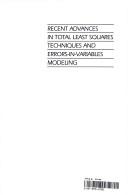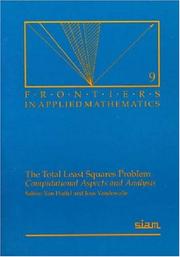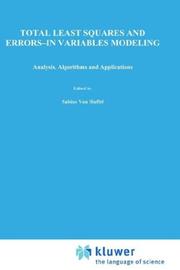| Listing 1 - 10 of 167 | << page >> |
Sort by
|
Book
ISBN: 9076671516 Year: 2004 Publisher: Gent : Carmelitana,
Abstract | Keywords | Export | Availability | Bookmark
 Loading...
Loading...Choose an application
- Reference Manager
- EndNote
- RefWorks (Direct export to RefWorks)
Christian spirituality --- Deuil --- Rouw --- #GGSB: Dood & Levenseinde --- getuigenis --- dood --- kinderen --- afscheid (x) --- C1 --- 418.7 --- Rouw - Rouwverwerking --- Dood --- Kerken en religie --- Dood & Levenseinde --- #gsdb6

ISBN: 0898713935 Year: 1997 Publisher: Philadelphia (Pa.) SIAM
Abstract | Keywords | Export | Availability | Bookmark
 Loading...
Loading...Choose an application
- Reference Manager
- EndNote
- RefWorks (Direct export to RefWorks)
Error analysis (Mathematics) --- Least squares --- Congresses
Book
Publisher: Loc. var. nom. var.
Abstract | Keywords | Export | Availability | Bookmark
 Loading...
Loading...Choose an application
- Reference Manager
- EndNote
- RefWorks (Direct export to RefWorks)

ISBN: 0898712750 9780898712759 Year: 1991 Volume: 9 Publisher: Philadelphia (Pa.): Society for industrial and applied mathematics,
Abstract | Keywords | Export | Availability | Bookmark
 Loading...
Loading...Choose an application
- Reference Manager
- EndNote
- RefWorks (Direct export to RefWorks)
Operational research. Game theory --- Moindres carrés --- Least squares --- Academic collection --- #TELE:SISTA --- 519.6 --- Method of least squares --- Squares, Least --- Curve fitting --- Geodesy --- Mathematical statistics --- Mathematics --- Probabilities --- Triangulation --- Computational mathematics. Numerical analysis. Computer programming --- Least squares. --- 519.6 Computational mathematics. Numerical analysis. Computer programming --- Moindres carrés

ISBN: 1402004761 9048159571 9401735522 Year: 2002 Publisher: Dordrecht ; Boston ; London Kluwer Academic Publishers
Abstract | Keywords | Export | Availability | Bookmark
 Loading...
Loading...Choose an application
- Reference Manager
- EndNote
- RefWorks (Direct export to RefWorks)
In response to a growing interest in Total Least Squares (TLS) and Errors-In-Variables (EIV) modeling by researchers and practitioners, well-known experts from several disciplines were invited to prepare an overview paper and present it at the third international workshop on TLS and EIV modeling held in Leuven, Belgium, August 27-29, 2001. These invited papers, representing two-thirds of the book, together with a selection of other presented contributions yield a complete overview of the main scientific achievements since 1996 in TLS and Errors-In-Variables modeling. In this way, the book nicely completes two earlier books on TLS (SIAM 1991 and 1997). Not only computational issues, but also statistical, numerical, algebraic properties are described, as well as many new generalizations and applications. Being aware of the growing interest in these techniques, it is a strong belief that this book will aid and stimulate users to apply the new techniques and models correctly to their own practical problems.
Least squares --- Error analysis (Mathematics) --- Academic collection --- 681.3*I54 --- Errors, Theory of --- Instrumental variables (Statistics) --- Mathematical statistics --- Numerical analysis --- Statistics --- Method of least squares --- Squares, Least --- Curve fitting --- Geodesy --- Mathematics --- Probabilities --- Triangulation --- Applications: computer vision; signal processing; text processing; waveform analysis (Pattern recognition) --- Least squares. --- Error analysis (Mathematics). --- 681.3*I54 Applications: computer vision; signal processing; text processing; waveform analysis (Pattern recognition) --- Algebra. --- Matrix theory. --- Statistics . --- Applied mathematics. --- Engineering mathematics. --- Numerical analysis. --- Algorithms. --- Linear and Multilinear Algebras, Matrix Theory. --- Statistics, general. --- Applications of Mathematics. --- Numeric Computing. --- Algorism --- Algebra --- Arithmetic --- Mathematical analysis --- Engineering --- Engineering analysis --- Statistical analysis --- Statistical data --- Statistical methods --- Statistical science --- Econometrics --- Foundations
Book
Year: 1991 Publisher: Philadelphia Society for industrial and applied mathematics
Abstract | Keywords | Export | Availability | Bookmark
 Loading...
Loading...Choose an application
- Reference Manager
- EndNote
- RefWorks (Direct export to RefWorks)
Book
ISBN: 9789085282075 Year: 2011 Volume: 2 Publisher: Antwerpen Halewijn
Abstract | Keywords | Export | Availability | Bookmark
 Loading...
Loading...Choose an application
- Reference Manager
- EndNote
- RefWorks (Direct export to RefWorks)
Huffel, Van, Sabine --- Christelijk leven --- Christian life --- Vie chrétienne --- C5 --- levensbeschouwing --- Academic collection --- #gsdb10 --- Maatschappelijke organisaties en maatschappelijk leven --- Religion --- Philosophy
Book
Year: 2015 Publisher: Leuven KU Leuven.Faculteit ingenieurswetenschappen
Abstract | Keywords | Export | Availability | Bookmark
 Loading...
Loading...Choose an application
- Reference Manager
- EndNote
- RefWorks (Direct export to RefWorks)
The rate at which our heart beats, is a dynamical process enabling adaptive changes according to the demands of our body. These variations in heart rate are widely studied in so-called heart rate variability (HRV) analyses, as they contain much information about the activity of our autonomic nervous system. Variability in the heart rate arises from several processes, such as thermoregulation, hormones, arterial blood pressure, respiration, etc. One of the main short-term modulators of the heart rate is respiration. This phenomenon is called respiratory sinus arrhythmia (RSA) and comprises the rhythmic fluctuation of the heart rate at respiratory frequency. It has also widely been used as an index of vagal outflow. However, this has been widely debated as some studies have shown that the magnitude of RSA changes with respiratory rate and the depth of breathing, independently of parasympathetic activity. It is therefore questioned whether RSA represents a true index of vagal outflow. The lack of consensus on the precise mechanisms that are responsible for this cardiorespiratory interaction, lead to interpretational problems. It is nevertheless apparent that it is important to include information of respiration when interpretations of HRV studies are conducted. Inspired by the polemic nature of this debate on the interpretation of RSA, this dissertation focuses on three topics. The first part of the thesis deals with the development of a surrogate respiratory signal based on ECG recordings. This is termed ECG-derived respiration (EDR). It is an important topic to cope retrospectively with possible confounding respiratory parameters in HRV studies without separate respiratory recordings. Additionally, with the trend towards less obtrusive and more cost-efficient monitoring, the possibility to obtain reliable EDR signals would discard the need to separately record respiration using specialized equipment, that often also interferes with natural breathing. In this dissertation, a new algorithm is proposed for single lead ECGs and compared with state-of-the-art EDR methods. The second focus of the thesis is closely related to the interpretational problems concerning RSA and cardiac vagal activity. As such, the aim is to separate the tachogram in two components: one that is strictly related to respiration, and another component that is unrelated to respiration. Several methods to realize this separation have been proposed in the literature, and an extensive comparison is conducted in this thesis. Additionally, a separation method based on partial time-frequency analyses is discussed. It has the advantage over other methods that it can deal with nonstationary signals. The last part of this dissertation focuses on the characterization of common dynamics in HRV and respiration. It is well-known that the interactions that play in the cardiorespiratory system are complex. Although the common dynamics have been studied in the literature using techniques like synchronization, symbolic dynamics and coupled oscillators, the precise mechanisms are still unclear. Therefore, we aim to characterize the common dynamics in a different way in order to gain more insight in the underlying cardiorespiratory mechanisms and their interpretation. In particular, information-theoretic measures that quantify the information storage and internal information of HRV, and the information transfer and cross information from respiration to HRV are discussed. Throughout this dissertation, special attention is also paid to the application of mental stress monitoring. It has been found that persons who are chronically stressed, have an increased risk for cardiovascular diseases. Also breathing plays an important role, as research suggests that respiration can be used as an interface to deal with negative effects of mental stress, and thus alter cardiac autonomic activity. This makes mental stress an interesting application on which the impact of the last two topics is evaluated.
Dissertation
Year: 1987
Abstract | Keywords | Export | Availability | Bookmark
 Loading...
Loading...Choose an application
- Reference Manager
- EndNote
- RefWorks (Direct export to RefWorks)
Dissertation
Year: 1987 Publisher: Leuven KU Leuven. Faculteit Ingenieurswetenschappen
Abstract | Keywords | Export | Availability | Bookmark
 Loading...
Loading...Choose an application
- Reference Manager
- EndNote
- RefWorks (Direct export to RefWorks)
| Listing 1 - 10 of 167 | << page >> |
Sort by
|

 Search
Search Feedback
Feedback About UniCat
About UniCat  Help
Help News
News